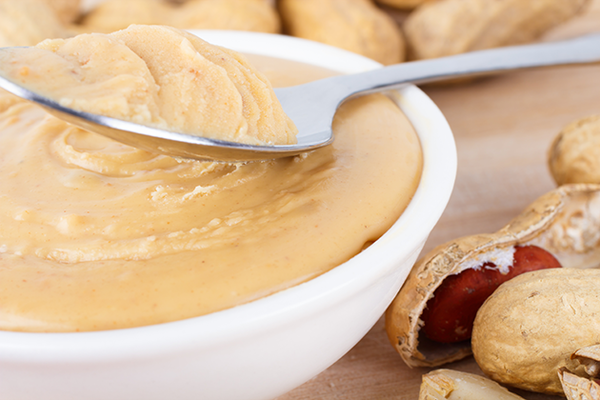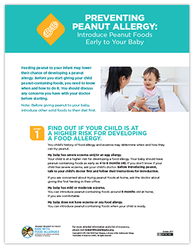The National Institute of Allergy and Infectious Diseases’ (NIAID), part of the National Institutes of Health (NIH), released new guidelines today to help prevent the development of peanut allergy.
Why the New Recommendations?
For years, guidelines told us that parents and pediatricians should delay giving peanut-containing foods to children until after age three. However, all of our best evidence now shows that early introduction of peanut-containing foods is associated with less peanut allergy.
In 2015, a landmark study called LEAP (Learning Early About Peanut Allergy) provided strong evidence that early introduction of peanuts prevents the development of peanut allergy in many children.
LEAP findings showed that the group of at-risk infants who ate 2 grams of peanut three times a week had significantly less allergy to peanuts at 5 years of age compared with infants who avoided peanut. The at-risk babies were all less than 12 months of age with eczema and/or egg allergy.
LEAP is important because it was the first study of its kind to show how giving peanuts early to high-risk infants can effectively prevent the development of the allergy.
Because of LEAP and a few more studies, an expert panel of doctors, scientists, and public health experts created new guidelines for early introduction of peanut to infants.
New Guidelines: When and How to Introduce Peanuts to Infants
The guidelines could have far-reaching impacts on the development of new cases of peanut allergy.
The new guidelines recommend that before 11 months of age, all infants should start eating age-appropriate peanut-containing foods. The ideal age is closer to six months.
View video on YouTube and find additional resources
For full background information and specific details, please read the guideline document. The information in this blog post is an introduction to new concepts and a general guide. And of course, speak with your child's doctor first.
The guidelines for introducing peanuts to infants will depend on their risk of peanut allergy. Work with your doctor to identify your child’s risk beginning around 4 months of age.
There are three groups for infants according to the guidelines:
- Severe eczema, egg allergy or both
- Mild to moderate eczema
- No eczema or any food allergy
Group 1: Severe eczema, egg allergy or both
- This group is at highest risk to develop peanut allergy and would benefit most from early introduction
- A physician (allergist) should evaluate peanut sensitization (by skin prick or blood IgE test) before introduction of peanuts
- No sensitization (negative IgE testing) indicates very low risk for allergic reaction upon introduction
- The presence of mild sensitization should not prevent peanut introduction, but may change how it is introduced
- High levels of sensitization indicate probable peanut allergy. The baby should see an allergist to determine next steps
Group 2: Mild to moderate eczema
- These infants do not need peanut IgE testing before introduction
- It is recommended that these infants be introduced to age-appropriate peanut-containing foods as early as 4 to 6 months of age
- Infants should already be eating other solid foods to show developmental readiness to add peanut-containing foods into their diet
- Some caregivers and health care providers may desire an in-office supervised feeding and/or evaluation before to introduction
Group 3: No history of eczema or food allergy
- These infants do not need peanut IgE testing before introduction
- It is recommended that these infants be introduced to age-appropriate peanut-containing foods as early as 4 to 6 months of age
- These infants do not need a medically-supervised feeding
Other consideration: No/mild history of eczema or food allergy but a family history of peanut allergy
- This is not a guideline included in the LEAP study, but the question comes up often
- Data from randomized controlled trials do not exist for this group of infants
- Data are limited about risk of peanut allergy in this group. Some studies show increased risk of peanut allergy compared with infants who do not have a family history
- Due to potential benefit, it is recommended that these infants have age-appropriate peanut-containing foods introduced into their diets around 4-6 months of age
- Parents and health care providers may decide whether to test for sensitization and method of introducing peanuts, given the lack of data in this group.
How Much Peanut Do Infants Need to Eat?
- In LEAP, infants ate 2 grams of peanut three times a week
- It remains unknown whether lesser amounts, or less frequent feedings, will offer the same benefit in prevention of peanut allergy
- Once babies are successfully eating peanut, they should continue to do so on a regular basis (unless concerns for a new allergic reaction arise)
- The total amount of peanut protein to be consumed per week should be 6 to 7 grams over three or more feedings
- In the LEAP study, 75% of children were able to eat this amount of peanut through the entire study.
 What Type of Peanut-Containing Foods Should Parents Give to Infants?
What Type of Peanut-Containing Foods Should Parents Give to Infants?
- Is the baby ready to eat solid foods? This is the first consideration. They should already be eating other solid food before introducing any peanut-containing foods.
- Never give an infant whole peanuts, chunks or undiluted peanut butter. The baby could choke.
- There are several types of food to use to offer 2 grams of peanut protein per feeding:
1. Peanut containing puffs or sticks:
- 21 sticks = ~2 g of peanut protein
- Infants < 7 months of age: soften with 4-6 teaspoons of water
- Older infants can eat unmodified but can also soften, if desired
2. Thinned smooth peanut butter:
- Measure 2 teaspoons of peanut butter and slowly add 2-3 teaspoons of hot water
- Stir until dissolved and well blended
- Let cool
- Increase water amount if necessary, or add to their regular infant cereal to achieve consistency comfortable for the baby
3. Smooth peanut butter puree:
- Measure 2 teaspoons peanut butter
- Add 2-3 tablespoons of pureed tolerated fruit or vegetables to peanut butter
- Adjust volume of puree to achieve desired consistency
4. Peanut flour and peanut butter powder:
- Measure 1 teaspoon of either produce (both interchangeable)
- Add 2 tablespoons of pureed tolerated fruit or vegetable to flour or powder
- Volume of puree can be adjusted to achieve desired consistency
Important Points for Consideration
- These guidelines only apply to infants who have not eaten peanut or experienced any reaction to peanut
- If an infant is already consuming peanut-containing foods without problems, then they are not allergic. They should continue to eat peanut regularly as outlined above – they do not need any evaluation or testing
- If symptoms suggesting an IgE-mediated allergic reaction have previously occurred (hives, swelling, anaphylaxis) after ingestion of peanut, then that infant should be evaluated for suspected peanut allergy. This visit should occur quickly. The risk of developing peanut allergy increases with age.
- Parents should contact their health care provider for additional evaluation of possible peanut allergy if infants have alarming symptoms after introducing peanuts.
- These guidelines address prevention of peanut allergy and do not apply to anyone with known or existing peanut allergy. You should not confuse these guidelines with treatment recommendations or any form of immunotherapy.
Download our handout Preventing Peanut Allergy: Introduce Peanut Foods
Early to Your Baby.
 Dr. David R. Stukus is an Associate Professor of Pediatrics in the Section of Allergy/Immunology at Nationwide Children’s Hospital in Columbus, Ohio. In addition to his interest in caring for families with food allergies and other allergic conditions, he also serves as the Director of the Complex Asthma Clinic. He previously completed his residency at Nationwide Children’s Hospital and his fellowship at the Cleveland Clinic. Dr. Stukus is the Chair of the Food Allergy and Anaphylaxis subcommittee of the Medical Scientific Council of the Asthma and Allergy Foundation of America. You can follow him on Twitter @AllergyKidsDoc.
Dr. David R. Stukus is an Associate Professor of Pediatrics in the Section of Allergy/Immunology at Nationwide Children’s Hospital in Columbus, Ohio. In addition to his interest in caring for families with food allergies and other allergic conditions, he also serves as the Director of the Complex Asthma Clinic. He previously completed his residency at Nationwide Children’s Hospital and his fellowship at the Cleveland Clinic. Dr. Stukus is the Chair of the Food Allergy and Anaphylaxis subcommittee of the Medical Scientific Council of the Asthma and Allergy Foundation of America. You can follow him on Twitter @AllergyKidsDoc.




Comments (0)